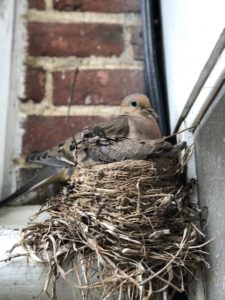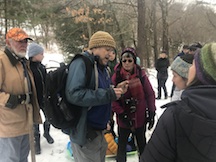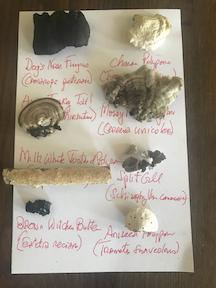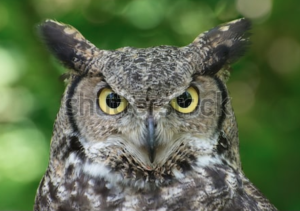By Ashton Nichols
Lovey (a.k.a. Lovey Dovey) is in residence at “Creekside,” our c. 1840 farmhouse. Lovey is a mourning dove, of the family Columbidae, and this year she has had the misfortune—largely self-imposed—of moving into last year’s sparrow’s nest for her spring mating and rearing of chicks.
She is twice the size of the sparrows who built this well-made nest last spring in our screened-in-porch. One morning Lovey’s head is hanging over the edge of the nest tucked into the brick wall of Creekside. The next morning her tail is hanging out of the nest, so far in midair that it looks as though she might plummet to the ground at any moment. But she stays firmly at her task, sitting tightly on top of those eggs, keeping the center of her small, down-lined nest at least close to her own body temperature.
The mourning dove (Zenaida macroura) is one of the most common birds of wildflower fields and suburban lawns, evident in in almost all of the lower forty eight states all year round, and in summer well into British Columbia in the West—along the Alaska passage—and in the East to the top of New Brunswick and Nova Scotia. The call is a muffled oo-wooo-coooo-wooo, and it lasts a long time; the book says often from four to six minutes. The birds also make a loud, flapping whistle every time they take off.
Chandler Robbins’s wonderful Birds of North America (a Golden Guide to Field Identification) reports that while these doves nest singly, they feed “in flocks.” Whether in a nearby flock or off completely on his own, Lovey’s mate showed up for the first time this morning, looking extremely well fed. He sat on the nearby waist-high metal fence for a long time. Then, he flew back into the neighboring maple tree, cooing all the while, and suddenly he flew up to Lovey’s nest, landed directly on top of her, and pushed her off into the air. She flapped twice and landed nearby in the yard’s largest maple tree.
Mourning doves are one of those bird species in which the male shares egg-sitting duties with the female: she typically sits all night and he during the day. He literally nudges her out of the nest when he lands. She acts almost surprised, and yet this must have happened every day since she laid her eggs. Now he sits there quietly, turning his head from side to side, and she flies off across the yard to gather food for herself and her offspring to be.
Yesterday, for the first time, we realized that two eggs had hatched in the sparrow/dove nest and that two newborns were lying still in their down-lined space. Lovey looked as though she could not get comfortable for most of the morning. She would stand, turn around, flap her wings — singly, or in unison — then peck toward the center of her nest as though something was annoying (or pleasing) her? By the afternoon, we could see two balls of fluff, their heads barely visible amid each feathery ball.
By noon today, Lovey as mother was feeding them for the first time. She disappeared without her mate replacing her and returned within the hour to begin feeding her magic dove’s milk. Mourning doves, like their close relatives — pigeons — make a milk-like substances in their digestive tract to feed their young. It looks more like cottage cheese and it has more proteins than cows’ milk; it also has more antioxidants and immune-producing substances. So Lovey is now putting her closed beak into her squabs’ tiny mouths, opening her bill, and regurgitating this life-giving fluid into each chick’s waiting gullet.
It is a spring full of birds at Creekside this year; some mornings we virtually feel like an aviary. A nearby robin occasionally fly out from her chest-high nest into the wide yard, coming back with a worm that she swallows. Soon these worms will not be for her. So far this spring, in addition to countless robins, we have seen the usual starlings, grackles, blackbirds, and sparrows, also several cardinals, mockingbirds, nesting house wrens, and—excitingly—a fluty-throated wood thrush, the flash of two Baltimore orioles and one gorgeous brilliant bluish-violet indigo bunting.
So, keep your eyes open all spring and—with any luck—you are likely to have ornithological sights galore surrounding you!
Ashton Nichols is the Walter E. Beach ’56 Distinguished Chair in Sustainability Studies and Professor of Language and Literature at Dickinson College




